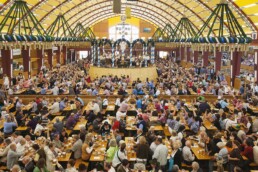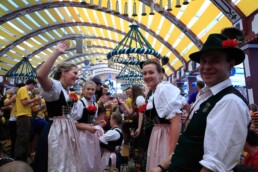Raise a Stein: Oktoberfest is Here!
Every October, the world raises a glass in honour of a centuries-old tradition that began in the heart of Bavaria: Oktoberfest. While the name conjures up pictures of foaming steins and busy beer halls, the history of Oktoberfest is far more interesting than a mere beer celebration. This legendary event, celebrated yearly in Munich and duplicated around the world, is based on a royal wedding, a time-honoured cultural tradition, and a global need for community and mirth.
The first Oktoberfest in German, took place on 12 October 1810. The occasion was the marriage of Crown Prince Ludwig of Bavaria (later King Ludwig I) and Princess Therese of Saxe-Hildburghausen. To commemorate this blissful coupling, the royal family asked Munich residents to join in the celebrations on the fields outside the city gates. These grounds, which became known as Theresienwiese (“Theresa’s Meadow”) in honour of the bride, continue to constitute the focal point of the event today. The first Oktoberfest featured a horse race, which pleased the citizens and established the tone for future events. The event was such a success that it became an annual tradition, eventually growing into the world-famous festival we know today.
While beer has become synonymous with Oktoberfest, it was not always the main attraction. In its early years, the festival was largely an agricultural display intended to promote Bavarian agriculture. For decades, Oktoberfest was a celebration of area produce, cattle, and rural crafts. Farmers and breeders from all across Bavaria would bring their best animals and produce, transforming the event into a large-scale agricultural show honouring the region’s rural heritage. It wasn’t until the late nineteenth century that beer took centre stage. Breweries began erecting big beer tents to serve thirsty festivalgoers, and by the 1890s, these tents had expanded into massive constructions capable of accommodating thousands of people. With beer at the centre of the celebration, Oktoberfest evolved into the iconic event that now attracts millions of people from all over the world.
The beer is crucial to Oktoberfest, and it’s not just any beer. The festival highlights the Märzen variety, a typical Bavarian beer produced especially for the occasion. Märzen, with its amber colour, full-bodied flavour, and higher alcohol concentration, was traditionally produced in March and held in cold cellars all summer. By October, the beer was wonderfully matured and ready to drink. Only six breweries are licensed to serve beer at Oktoberfest, and they are all situated in Munich. For more than a century, these breweries—Augustiner, Hacker-Pschorr, Hofbräu, Löwenbräu, Paulaner, and Spaten—have been central to the festival’s character. Their beer, served in enormous one-litre Maß steins, is noted for its distinct, rich flavour, which embodies Bavarian workmanship and traditions.
Today, Oktoberfest has expanded well beyond its Bavarian origins. Every year, almost six million people from all over the world gather in Munich for the 16- to 18-day event, making it the world’s largest folk festival. But, beyond the beer tents, Oktoberfest is a multidimensional event with a variety of activities celebrating Bavarian culture.
- Parades and Traditions: The festival kicks off with a magnificent parade through Munich’s streets, showcasing traditional Bavarian costumes, brass bands and horse-drawn beer waggons. The mayor of Munich taps the first keg in a ceremonial opening, shouting, “O’zapft is!” (“It’s tapped!”) to herald the start of the celebration. There is also a traditional riflemen’s march, which highlights Bavaria’s historic military and cultural legacy.
- Cultural Shows: Aside from the beer, Oktoberfest is a festival of Bavarian art, music, and dancing. Every day, authentic Bavarian folk music fills the air, played by ensembles dressed in lederhosen and dirndls. In the afternoons, guests can see performances of **Schuhplattler**, an explosive Bavarian dance involving rhythmic stomping and slapping of the thighs and shoes.
- Carnival Rides and Games: In keeping with the festival’s roots as a public celebration, Oktoberfest also features a large funfair. Carnival rides, roller coasters and games offer enjoyment to individuals of all ages. The historic Flea Circus, a modest yet unique institution, has been entertaining guests for almost a century.
- Delicious Bavarian Food: No Oktoberfest is complete without the accompanying Bavarian specialities. From gigantic pretzels and grilled sausages to roasted chicken and hog knuckles, the cuisine at Oktoberfest is as important as the beer. The festival menu include traditional Bavarian foods such as Weißwurst (white sausage) and Schweinshaxe (roasted pork knuckle).
- Family-Friendly Days: While Oktoberfest is primarily focused on beer, it has also evolved into a family-friendly event. Special “Family Days” feature discounted rides, food, and attractions, making the event suitable for people of all ages. These days highlight Oktoberfest’s community-oriented atmosphere, with something for everyone.
While Munich’s Oktoberfest remains the crown gem, it has spawned similar events around the world. Cities such as Kitchener-Waterloo in Canada, Cincinnati in the United States, and Blumena in Brazil hold their own large-scale Oktoberfests, tailoring the Bavarian custom to their respective cultures. In these places, revellers congregate in beer halls, donning traditional Bavarian costumes and toasting with steins of beer, resulting in a shared global experience. The core of Oktoberfest—community, festivity, and a strong love for tradition—is felt across boundaries. Whether in Munich’s large beer tents or smaller gatherings in cities around the world, the festival reflects a spirit of joy and celebration that brings people together.
It is more than just a beer festival; it’s also a historical, cultural, and traditional event. Oktoberfest, which began as a royal wedding celebration and has now grown to become a global phenomenon, exemplifies the continuing appeal of Bavarian hospitality and workmanship. The festival evolves each year, but its core stays the same: a joyful celebration of life, community, and Bavaria’s rich traditions.
So, as the fresh October air fills the streets and the sound of clinking steins echoes around the world, take a time to raise your glass. Whether you’re in Munich or halfway around the world, the spirit of Oktoberfest lives on, encouraging us all to appreciate the joy of good company and shared customs. Prost!


